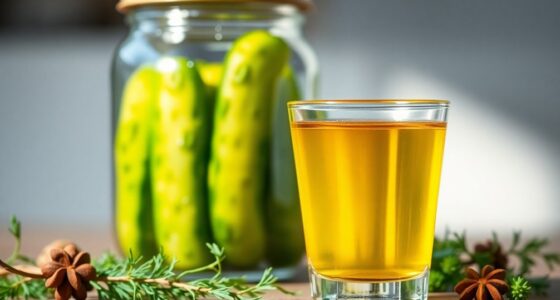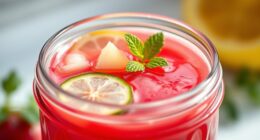One medium lime usually yields about 1 ounce of juice, which is around 2 tablespoons. This quantity can vary slightly between limes, but you can generally expect this amount for recipe accuracy. If you need more lime juice, remember that 1/4 cup typically requires two limes, while 1/2 cup needs about four. Knowing how much juice you'll get helps prevent last-minute store trips. Stick around to discover tips on selecting and juicing limes effectively!
Key Takeaways
- One medium lime typically yields about 1 ounce of juice, making it a reliable measurement for recipes.
- On average, expect around 2 tablespoons of juice from one lime, equivalent to 1 ounce.
- Juice yield can vary slightly between limes, so consider this for precise recipe needs.
- Firm and heavy limes generally provide better juice extraction compared to lighter ones.
- Rolling the lime before cutting can help maximize the juice yield during extraction.

When you’re cooking or mixing drinks, knowing how much juice you can get from one lime is essential. It’s a common question among home cooks and bartenders alike. On average, one medium lime yields about 2 tablespoons of juice, which is approximately 1 ounce. This information can be a game changer when you’re following recipes that require precise measurements. Additionally, if you’re using multiple limes for a larger batch, it’s helpful to remember that the juice yield can vary slightly based on the lime’s size and freshness. When you’re in a pinch and need to substitute or adjust, knowing exactly how much juice in a lime can save you time and prevent ingredient waste. So, whether you’re preparing a zesty marinade or mixing the perfect cocktail, keep this measurement in mind for best results.
Whether you're whipping up a zesty marinade or mixing a refreshing cocktail, understanding lime yields helps you get the right amount of fresh lime juice every time. If you're planning to make a recipe that calls for more juice, knowing how many limes to buy is just as crucial. For instance, if you need 1/4 cup of fresh lime juice, you'll typically need about two limes. If your recipe requires 1/2 cup, then you should expect to use around four limes.
It's a straightforward calculation that allows you to prepare without any last-minute trips to the store. Remember, while the juice yield can vary slightly from lime to lime, you can generally rely on each lime producing around 1 ounce of juice.
When you're juicing, it's important to select firm, heavy limes for maximum juice extraction. These limes not only feel more substantial in your hand, but they also promise a better yield. Before you cut the lime, take a moment to roll it on a countertop. Rolling the lime helps to break down the internal membranes, making it easier to extract juice. This simple step can significantly increase the amount of fresh lime juice you get from each fruit.
Once you've rolled the lime, it's time to cut it. You can slice it in half horizontally or vertically, depending on your preference. Either way, make sure you're using a sharp knife to get the cleanest cut possible. When you press down on the lime, you'll find that the juice flows more freely when you've prepared it properly.
If you want to get every last drop, consider using a citrus juicer or reamer. These tools can help you extract every bit of juice without much effort. Incorporating fresh lime juice into your recipes can elevate flavors and add a refreshing zing. From tangy dressings to vibrant cocktails, lime juice is a versatile ingredient that enhances many dishes.
Frequently Asked Questions
How Many Ounces of Juice Are in One Lime?
When you squeeze a medium lime, you'll typically get about 1 ounce of juice.
This amount can vary slightly based on the lime's size and ripeness, but generally, you can count on that ounce for your recipes.
If you need more juice, just grab another lime or two.
How Much Juice Is Equal to One Lime?
Juicing a lime is like unlocking a burst of sunshine.
When you squeeze one medium lime, you’ll typically get about 2 tablespoons of juice, which is around 1 ounce. Depending on the size and ripeness of the lime, you may find variations in the amount of juice you can extract. When trying to estimate how much juice from a lime you can expect, it’s helpful to remember that juicing techniques and the fruit’s freshness can also play significant roles in yield. If you need a larger quantity of juice for recipes, consider using multiple limes to ensure you have enough for your needs.
This consistent yield makes it easy for you to measure out lime juice for your recipes.
How Much Juice Is in One Key Lime?
When you squeeze one key lime, you'll typically get about 1 to 2 tablespoons of juice, which translates to roughly 0.5 to 1 ounce.
If you're making a recipe that requires more juice, keep in mind that you'd need about 20 key limes to yield 1/2 cup.
Their higher acidity and unique flavor make them a favorite for dishes like key lime pie, so don't skimp on the juicing!
Can I Substitute Bottled Lime Juice for Fresh Lime Juice?
You're in the kitchen, ready to whip up something delicious, but you realize you're out of fresh limes.
Can you substitute bottled lime juice? The answer's a bit tricky.
While you can use bottled juice, it won't deliver the same vibrant flavor. Fresh lime juice brings brightness that bottled simply can't match.
If you're in a pinch, go ahead, but for the best taste, always reach for fresh limes when you can!
Conclusion
In the world of limes, each fruit contains a burst of sunshine, typically yielding about 1 to 2 tablespoons of juice. Picture that vibrant green orb as a small treasure chest, holding the zest of summer within. When you squeeze it, you're not just extracting juice; you're releasing memories of warm days and refreshing drinks. So, the next time you reach for a lime, remember—it's more than just an ingredient; it's a little piece of joy waiting to brighten your dish.
Cindy thoroughly researches juicing trends, techniques, and recipes to provide readers with practical advice and inspiration. Her writing style is accessible, engaging, and designed to make complex concepts easy to understand. Cindy’s dedication to promoting the advantages of juicing shines through her work, empowering readers to make positive changes in their lives through the simple act of juicing.











